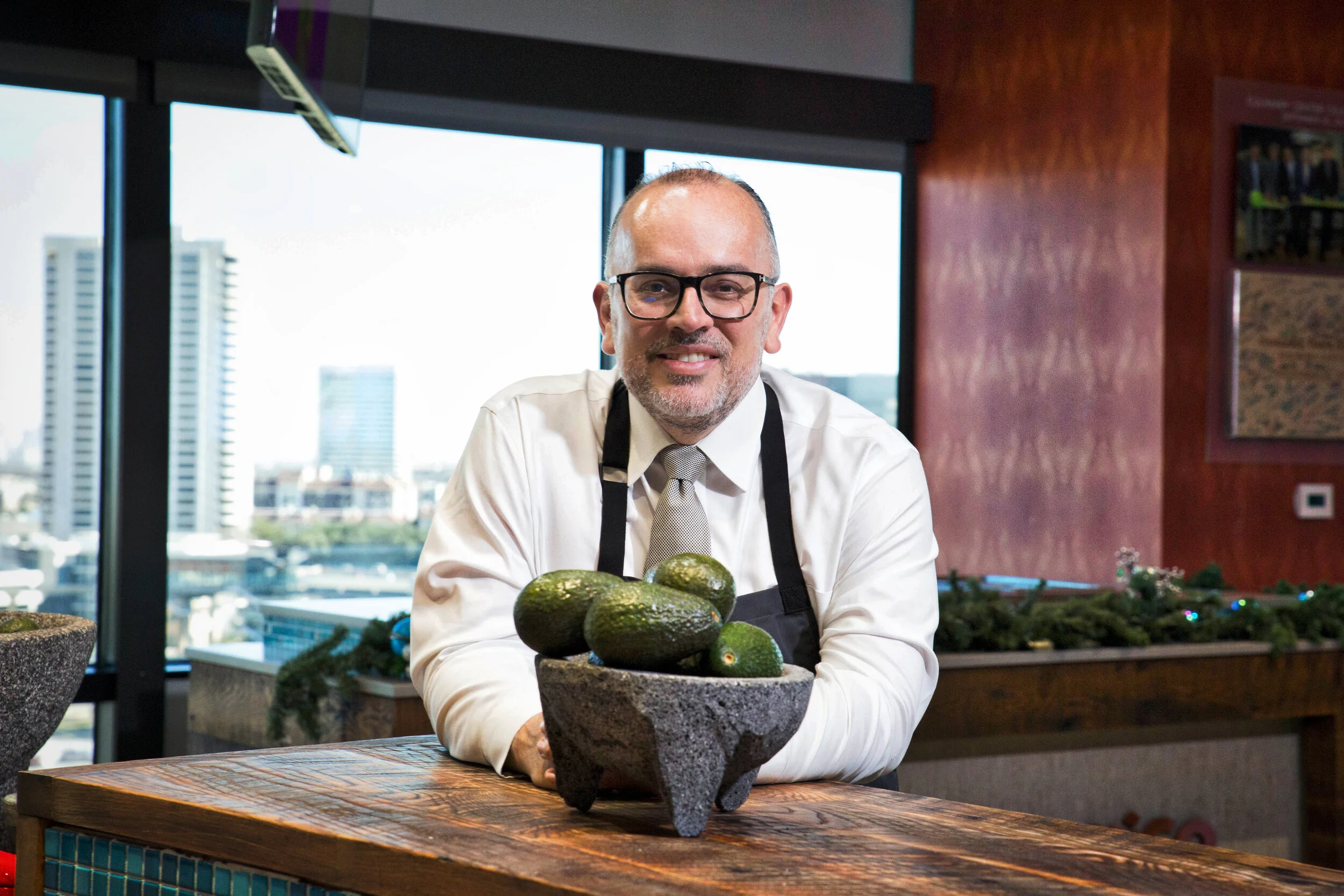Binational Leadership
Avocados from Mexico CEO, Alvaro Luque, plays the powerful leadership role in a binational joint effort to market the avocado in both the U.S. and in Mexico.
By: Timothy Baler
What do we love to eat in the United States? Hamburgers with ketchup. French fries with ketchup. Hot dogs and mustard. Pizza with just about anything you can imagine. Lots and lots of cereal. Lots of ice cream. And lots and lots of peanut butter.
If this was a foot race, those foods would be leading the pack. However, for the past 20 years or so a dark horse has entered the race, coming on so fast that it seems to have come out of nowhere. It almost has. Up until 1996 and for eighty years prior to that, imports of the avocado from Mexico were banned in the United States. The most common explanation was a fear of pests, but the more obvious problem was a fear of competition, which threatened avocado growers in California and Florida. But the fact is, many avocados from those states were not great sellers, anyway. Avocados languished in the supermarket with few people aware of how to make use of one. The health aspects were relatively unknown. And those who knew about guacamole either didn’t know how to make it or didn’t want to scare their guests by serving it.
The most common use for an avocado prior to 1997 seemed to be extracting the pit and suspending it above some water in a glass to explain plant growth at an elementary school science fair.
Not anymore. From a market point of view, the incredible growth rate of awareness and enjoyment of this quietly quenching, tangy, demure and mysterious fruit has hit the U.S. market by storm. Last year says Avocados From Mexico Chief Executive Officer Alvaro Luque, the U.S. imported more than two billion pounds of avocados from the Mexican state of Michoacan, the only state permitted to export to the United States. In that time, from 1997 to today, the number of growers and packers in Michoacan has swelled from about 22,000 to over 30,000 with an astounding 75 percent of those cultivating less than five acres of avocado trees. In the world of increasingly massive corporate farms, the avocado remains an anomaly, representing an agrarian lifestyle that many thought was going away – farmers making a living with small holdings. For, as remarkable as this sounds, avocados in 20 years have flipped what is assumed to be a universal law of supply and demand. While the supply of avocados has jumped by 2 billion pounds since 1997, the price of the fruit has just about doubled, climbing from about 70 cents per pound to between $1 and $2.
There are so many surprises in the story of the modern avocado it would be impossible to include them all here, but the truth is, a group of remarkable marketers has been behind this import success story all along. Today, who doesn’t say football, beer, corn chips and guacamole all in the same breath and who doesn’t complain when a restaurant skimps you on avocado slices in your salad? In so many words: Today, guacamole, tomorrow the world. At Avocados From Mexico (AFM), developers are aware that stunning new avocado recipes are no longer falling on deaf ears. In fact, the market is hungry for them. Avocados for dessert? Why not? The AFM website includes an imaginative line up including avocado with white chocolate, maybe a mint leaf, and raspberry coulis. Avocado cheesecake? Pull up a chair. Avocado with grilled shrimp? Don’t go away. Avocado fajita turkey burgers or avocado breakfast shake – your choice. Avocados in tortilla wraps, avocado nut gingerbread. Avocado with bacon, eggs, fish and peppers. Avocado with basil, poultry or cucumber.
Lovely. This is the fruit that is exotic enough to be a nice surprise on a special occasion, but useful enough to be an everyday staple. What did we do without it? At this point, it’s hard to recall.
In fact, Luque says, market penetration in the United States has reached over 50 percent, making what was recently all but unknown a common treat, but not an everyday item. So there’s room for growth and AFM considers growth their mission. Protect the market, and, Luque says, and watch it grow.
But how did we even get here? Certainly, some fortuitous events marked the creation of AFM, but it took a hardworking staff to grab the bull by the horns and run with it. For an organization that is only six years old and has, to date, a consistent string of high-ranking Super Bowl advertisements to its credit, their story is remarkable.
The building blocks for AFM began to take form with the eighty-year ban of Mexican avocado imports was lifted in 1997. Limited only to Michoacan avocados, the United States first opened nineteen northeastern U.S. states to Mexican avocado growers, allowing that number to grow in halting steps in 2001, 2004, and 2007, when California and Florida completed the list, allowing imports to every state. Avocados, however, remains a commodity, the same as corn, wheat, apples and oil, which means prices are negotiated on a daily basis. In this case, American importers, who soon tired of the practice of arguing prices with 20,000 Mexican growers and packers, asked their neighbors south of the border to create a trade group, that would represent the Mexican avocado industry. This gave rise to the Association of Mexican Exporters of Hass Avocados (Hass being the most popular cultivar.) In turn, avocado importers formed their own competing trade group, the Mexican Hass Avocado Importers Association.
Both groups, of course, were on opposite sides of price negotiations, but they otherwise shared the same goals. In fact, they shared the same jingle, the same logo and, all things said and done, the same purpose: Growth of the U.S. avocado market.
In 2013, they created history by merging. For the first time in U.S. history, two foreign trade associations merged to create on U.S.-based company. Avocados from Mexico is tat company and, it could be said, the juggernaut they hoped would bring the ancient fruit into the modern age.
You could also say, in effect, mission accomplished. And, of all things, it started with only a staff of six people in 2013. Five months later, Alvaro Luque arrived on the scene.
Born and raise in Costa Rica, Luque has had marketing in his blood since as long as he can remember and a track record to back it up. His specialty is the food industry and this includes a successful rise up the corporate chain of command when he became vice president of marketing for Gruma Maseca, the snack and flour brand that is dominant in Latin America.
Luque, who calls Gruma Maseca CEO Roberto Gonzalez Barrera an inspiration and a mentor, worked for the notoriously tough businessman as vice president of marketing in Venezuela, then all of Latin America, then North America in a series of jobs that marked him as a force to be reckoned with. As luck would have it, Barrera was a huge fan of marketing, as Luque said, he presented a marketing plan to Barrera and others for eight hours straight on one occasion. Barrera, he said, stayed through the entire eight hours, asking meaningful questions throughout the marathon presentation.
Now, six years after AFM recruited him, Luque has not lost his passion. He wants to protect the fruit’s market and make it grow with the backing of tens of thousands of small farmers from Mexico. “I think you need to be sure every time you put something in your mouth,” he said, “that has to be more than what you’re tasting. It has to be connected to your heart and to your mind to be able to relate to it.”
Luque calls this 360-degree marketing, leaving no quarter unchecked by making sure every interaction the consumer has with a product promotes the brand. “Three-hundred sixty degrees gives you a lot of opportunities,” he said.
And what has Luque learned? The secret to being a CEO is balance, he said. The organization needs creative minds, innovators, people who will take a step forward, but it also needs bread and butter worker bees who make sure the daily chores are done – the payroll, the accounting, the human resources part of the business. You also have to be prepared for crisis. “There are so many crisis,” he said. “You have to take care of them.”
Secondly, says Luque, AFM has yet to lose one top-level staff member in the past six years. That’s a 100 percent retention rate among the top staff.
How do you top all this? You keep it going and enjoy the ride. Adweek calls the rise of AFM from nothing to heavyweight Super Bowl ad contender in just six years one of the most remarkable marketing success stories in memory. How do you top that? You top it off with avocados, of course.


